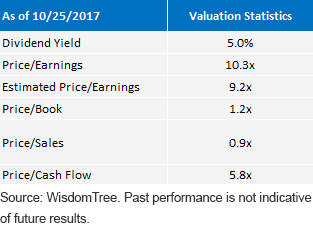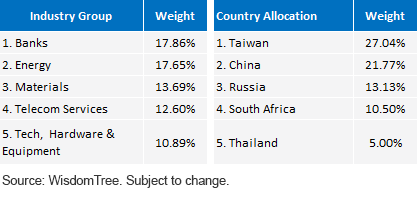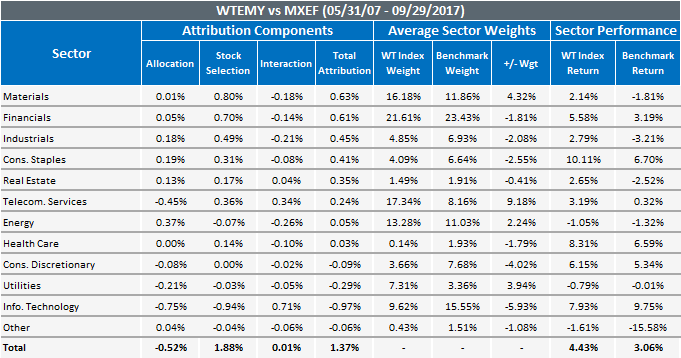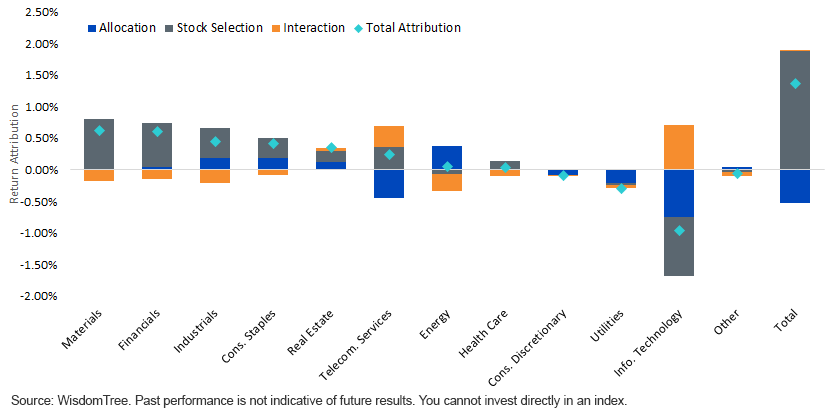Where to Find Value Today


After a general sustained rise in asset prices over the last seven to eight years, there are not many asset markets today where investors look at valuations and see bargain-basement prices. The conventional narrative is that U.S. markets are “expensive” compared to foreign markets like Europe, Japan and some emerging markets. But where are valuations really the most attractive?
Every year, WisdomTree conducts an annual rebalance of its global and emerging market Indexes in October. We just completed the rebalance across our emerging markets dividend family, and the valuations in this part of the world, I would argue, are still in a relatively depressed state.
In particular, I would point to the WisdomTree Emerging Markets High Dividend Index as symbolic of these low levels of market multiples. The valuation table below is displayed on our website every day, and it shows a dividend yield of 5%, a trailing 12-month P/E ratio around 10x and an estimated P/E ratio in the single digits. When we look at valuations across the world, there are no indexes WisdomTree has with lower valuation multiples.
Index Valuation Statistics

Where is this Index allocated to achieve these low multiples?
Of course, all investments contain risks, and when it comes to equities, emerging markets are at the higher end of the risk spectrum. So these low valuations entail a higher level of risk than U.S. equities. In terms of specific sector and country risks, the below table displays the top industries and top country risks.
The industry groups with the lowest multiples today are banks, energy companies and materials, which are more cyclical and tied to global growth prospects. Country-wise, there are large allocations to Taiwan and China, followed by Russia and South Africa.

Some of the biggest relative differentials when comparing the WisdomTree Index to the broader MSCI Emerging Markets Index are the allocations to commodities and energy stocks versus technology stocks.
Tech stocks, and Chinese tech stocks in particular, have been rising at fast rates in 2017, and their weight in a cap-weighted index has been rising disproportionately. These stocks are not high dividend payers, so on a relative basis, this high dividend index has been an out of favor factor in 2017, but also in the previous three to five years.
Detailed Look at Attribution
WisdomTree has started providing more detailed attribution analysis for a number of its Indexes, and this Index is one with such information available. The attribution provides context around how various sectors contributed to returns of the WisdomTree Index and its benchmark. Going back 10-plus years, the WisdomTree Emerging Markets High Dividend Index has outperformed the MSCI Emerging Markets Index by 137 basis points (bps) per year, and most of this benefit came from stock selection—even more so than the allocation percentages. Being under-weight to technology over the life of the Index the last 10 years was one of the drawbacks from performance. But for those who think technology stocks—the best performing sector over the last 10 years—might revert, this high dividend index could start to see more positive benefits from sector allocation differentials.


That is one reason I see this Index as one where there are relative valuation opportunities today. If an investor is looking to foreign markets as a source of value in today’s highly valued asset markets, this is an Index with both low absolute and relative multiples. I’m hearing some feedback from those looking at strength in long-term track record but recent underperformers. This Index fits the bill for those who are looking for asset class mean reversion.

Jeremy Schwartz has served as our Global Chief Investment Officer since November 2021 and leads WisdomTree’s investment strategy team in the construction of WisdomTree’s equity Indexes, quantitative active strategies and multi-asset Model Portfolios. Jeremy joined WisdomTree in May 2005 as a Senior Analyst, adding Deputy Director of Research to his responsibilities in February 2007. He served as Director of Research from October 2008 to October 2018 and as Global Head of Research from November 2018 to November 2021. Before joining WisdomTree, he was a head research assistant for Professor Jeremy Siegel and, in 2022, became his co-author on the sixth edition of the book Stocks for the Long Run. Jeremy is also co-author of the Financial Analysts Journal paper “What Happened to the Original Stocks in the S&P 500?” He received his B.S. in economics from The Wharton School of the University of Pennsylvania and hosts the Wharton Business Radio program Behind the Markets on SiriusXM 132. Jeremy is a member of the CFA Society of Philadelphia.

